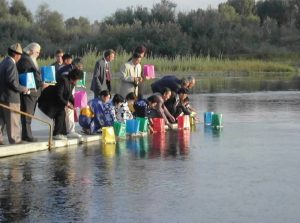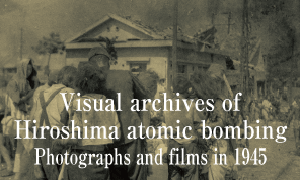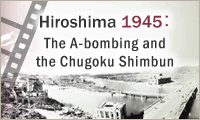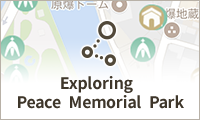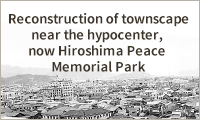Documenting Hiroshima 80 years after A-bombing: In August 1999, delegation visits Kazakhstan
May 21, 2025
Hiroshima citizens offer support to victims of radiation exposure
by Minami Yamashita, Staff Writer
In August 1999, 11 citizens from Hiroshima visited Kazakhstan, home to the former Soviet Union’s largest nuclear test site. It was the first delegation by the citizens’ group known as the “Hiroshima Semipalatinsk Project” (for short, “Hirosemi”). The purpose of the visit was to provide support to victims of radiation exposure in the local area including the city of Semipalatinsk (present-day city of Semey).
“I wanted to deliver support from Hiroshima, a city that understands the effects of radiation, and strengthen our solidarity,” said Keiichi Sasaki, 70, a resident of the city’s Asakita Ward who lost his mother at a young age after she had entered the city center and was exposed to radiation. He joined the delegation because he did not want to consider the damage and harm caused by nuclear testing as someone else’s problem.
Inspired by Asian Games held in Hiroshima
The impetus behind those efforts was the 1994 Asian Games, which were held in Hiroshima. As part of the “One Community Center, One Country Support Initiative,” each community center in the city was responsible for providing support to athletes from one country or region. The Suzugamine Community Center (in Hiroshima’s Nishi Ward) supported the team of athletes from Kazakhstan. Even after the Asian Games, residents in the area continued their interactions through visits to Semipalatinsk and other initiatives. Those interactions developed further, eventually leading to the formation of the Hirosemi Project in 1998.
At the Semipalatinsk nuclear test site, which is roughly the same size as Japan’s island of Shikoku, the Soviet Union conducted its first nuclear test in August 1949. During the Cold War and the ongoing nuclear arms race with the United States, the Soviet Union conducted upwards of 450 nuclear tests by the end of 1989. The test site was closed in 1991 following the collapse of the Soviet Union. Nevertheless, radioactive fallout, known as “ashes of death,” had fallen over an extensive area for many years.
Residents in the area complained of health effects, and medical institutions and scientists reported high incidences of leukemia and other cancers as well as an increase in children with birth defects. Meanwhile, Kazakhstan, which gained nation status after the collapse of the Soviet Union, was in dire financial straits at the time, with low standards of medical care and an underdeveloped transportation infrastructure. Mr. Sasaki recalled, “There were no medicines on hospital shelves, and test equipment was Soviet-made and inaccurate.”
Bring with them funds collected from contributions and other sources, Hirosemi donated a total of approximately 12 million yen in supplies to local medical institutions, including mobile medical examination vehicles and medicines. Takashi Hiraoka, 97, a resident of Hiroshima’s Nishi Ward who had retired from his post as mayor of Hiroshima, joined in the initiative. He said, “I wanted to volunteer as a citizen” and served as head of the delegation.
The delegation stayed in Semipalatinsk for around one week. In a meeting, the mayor of Semipalatinsk expressed his expectation for solidarity. “The 21st century must be one that is free of nuclear testing and war,” said the mayor. The delegates toured “ground zero” at the site of the first nuclear test and exchanged views with radiation victims and scientists. They also took part in a lantern-floating ceremony on one of the rivers in the city. During the period of the delegation’s visit, an A-bomb exhibition organized by the cities of Hiroshima and Nagasaki was held, attracting many local citizens.
Even after the visit, Hirosemi continued to send physicians and young people to the area as well as donate medicines and other supplies. Since 2000, the organization has facilitated the acceptance of Kazakh students to Sanyo Girls’ Senior High School (in Hatsukaichi City). Akerke Sultanova, 41, one of the first Kazakh exchange students, said, “I was impressed by the strong commitment of Hiroshima’s citizens to peace because, at the time, people in Semipalatinsk were preoccupied with their own lives and health.”
When she was young, she said she experienced “many eerie, earthquake-like tremors” and heard stories told by her mother, who was from a village near the test site, about how she had seen “mushroom clouds.” She had a relative, a woman, whose physical development had stopped at around the age of five. People around her said that her abnormality was “the fault of Polygon (common name for the test site).” She later came to understand the significance of that situation through the animated film “Barefoot Gen.”
“Solidarity with Hiroshima”
Ms. Sultanova applied for a one-year exchange program for Kazakh students that her father had discovered in the newspaper because she said, “I wanted to share the story of Semipalatinsk with the world.” While learning about the devastation caused by the atomic bombing of Hiroshima, she spoke at schools about the damages caused by nuclear testing. When she was in graduate school at Hitotsubashi University, where she enrolled in 2008, she wrote about her experiences and views in her master’s thesis.
Over the years, she felt that her home of Kazakhstan has developed economically and that its citizens have become more aware of peace. She said that, “Now, as the risk of nuclear weapons use escalates, the citizens of Hiroshima and Semipalatinsk must work together to convey the horror of nuclear weapons.” Ms. Sultanova now lives in Turkey, where she works to provide aid and support to radiation victims and promote citizen exchanges.
(Originally published on May 21, 2025)

